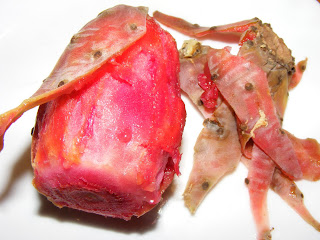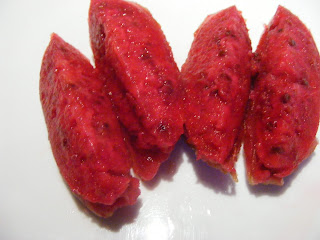 |
| Dried and (sad-looking but) fresh fruit of the prickly pear cactus. |
 |
| Xoconostle: chewy sour-sweet goodness! |
[This babble continues...]
Black Bean, Corn & Xoconostle Rice
Ingredient list:
- ½ cup dried xoconostle, cut into small pieces (or substitute plain dried cranberries)
- ½ cup pine nuts (or slivered almonds)
- 2 tablespoons vegetable oil
- 1 medium-sized onion, diced
- 1 ancho chili (or other mild chili, or a bell pepper), diced
- 2 cloves garlic, minced or crushed
- 1 tsp ground coriander seed
- 1 tsp ground cumin
- 1 tsp smoked paprika
- 1/2 tsp. ground cayenne powder
- 1 can (15 oz.) of black beans, drained
- 1 cup frozen or fresh corn kernels
- 6-7 branches of fresh thyme, leaves only (or about 1/2 tsp dried thyme)
- salt to taste
- ½ cup (loosely packed) chopped fresh coriander leaves, a.k.a. cilantro (or flat-leaf parsley, if you do not like cilantro)
- 2 tomatoes, diced
In a large frying pan, saute the onion in the oil until the onion pieces begin to brown. Add the garlic, ancho pepper and the dry spices (ground coriander seed, cumin, paprika and cayenne) and continue to saute until the pepper softens.
Add the drained beans, corn, and fresh thyme. Continue to cook until the beans and corn are warmed through. Then add the rest: the rice, drained xoconostle pieces, pine nuts, fresh coriander leaves, and diced tomatoes. Toss together well, salt to taste, and turn off the heat.
Last night, I enjoyed this dish with no-brainer nuked cheese enchiladas: Warm 2 tortillas in the microwave for 10 seconds, fill with sliced cheese, top with a few tablespoons for Trader Joe's red salsa and heat again until the cheese melts. Decorate with sour cream, tomato bits and cilantro. Serve up with black bean, corn and xoconostle rice.
Be sure to take yet another photo before diving in:
 |
| Gentle background heat of ancho and spices balanced with sweet and nutty bursts from the dried cactus fruit and pine nuts. |
Fresh Prickly Pear Fruit! In Ohio!
I do not think I've eaten the fruit of the prickly pear cactus before, although I am very familiar with the cactus “paddles” (nopales, in Spanish) that used to turn up in grocery stores in Seattle (and even, occasionally, in Walla Walla, WA, back in the 1980s). I LOVE nopales when they are cut into strips and grilled over charcoal.
Grilled nopales, dressed with lime juice, garlic and olive oil make a stunning addition to fish or chicken tacos. I've also had them in salads. In my opinion, they are somewhere between string bean and asparagus on the palate, though some people have told me that they remind them, uncomfortably, of okra. (Poor okra! The much-maligned veg! I enjoy okra—especially pickled okra--but only when it has not been abused or made to exude slime.)
If I had not been researching the dried xoconostle prize ingredient last week, I probably would not have noticed these sad examples sitting unlabeled and un-priced, like extraneous garnish about to be tossed away, in the produce section of the IGA in Struthers, Ohio.
Even though all my knowledge of this fruit comes from images on the Internet, I can tell that these three are undersized and well-traveled. Most of their little cactus thorns were gone or were partly broken, probably from being over-handled by curious Ohioans unaware of the dangers of holding cactus bare-handed.
Cutting into the first one was a bit of a shock. The color of the flesh incredibly vivid.
The papery skin peeled off easily. Inside, the flesh is riddled with extremely hard, uncrackable seeds. I had the idea of just eating these raw, unprocessed, but the seeds were numerous and off-putting. The flesh, however, is very pleasant, with the texture of kiwi.
Most of the recipes involving prickly pear fruit that I was able to find included a process of removing the seeds and creating a pulp of the flesh. The flesh is then turned into something sweet, like jam, jelly, sorbet or whatever.
I ended up putting my peeled, cut up cactus fruit into a bowl with 1/2 cup of filtered water, and pureeing it with an immersion blender. Then I strained out the seeds and froze the pulpy juice in an ice tray.
My idea right now is to use these brilliant red cubes in lemonade (for the visual effect) or maybe in some kind of cocktail involving tequila and lime juice. But I'll have to save that experiment for another day.







My Italian father is very fond of cactus pears called, ficadin', which is a contraction of fico d'India. We've always eaten them as is, peeling them carefully to avoid the spikes, and spitting the numerous hard seeds. Of course, they aren't the easiest thing to find in Ohio, but occasionally they can be had in the Italian markets down in Steubenville.
ReplyDelete